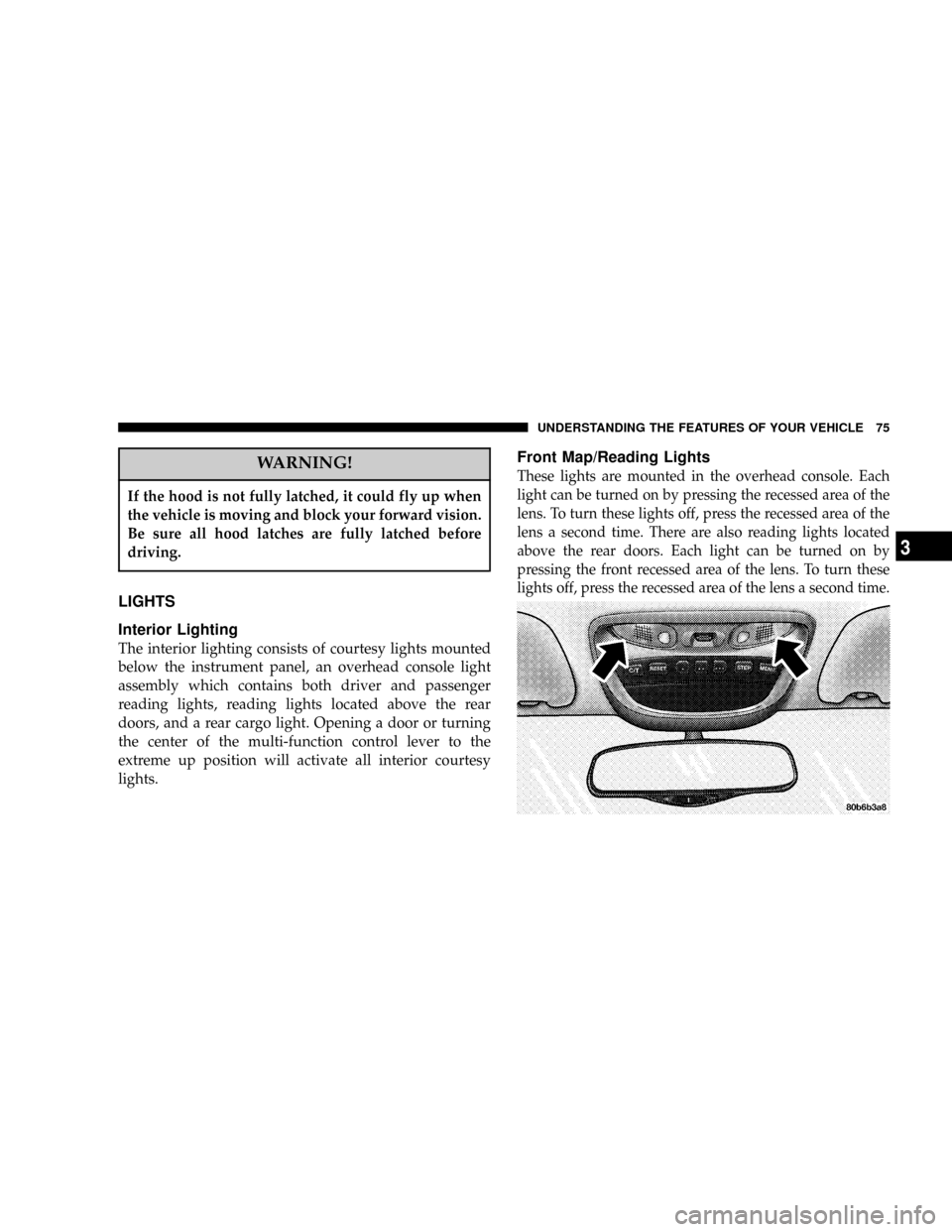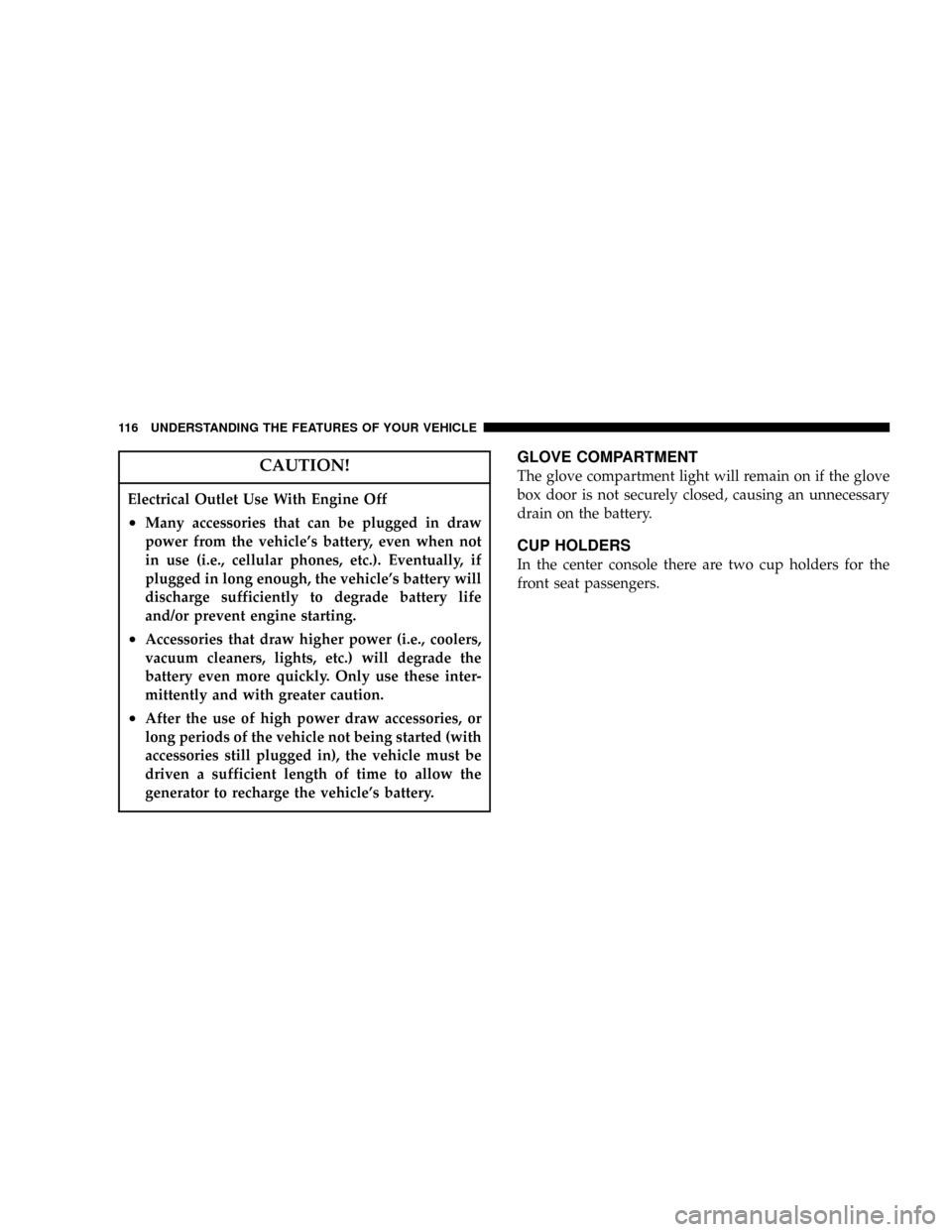center console JEEP GRAND CHEROKEE 2004 WK / 3.G Owners Manual
[x] Cancel search | Manufacturer: JEEP, Model Year: 2004, Model line: GRAND CHEROKEE, Model: JEEP GRAND CHEROKEE 2004 WK / 3.GPages: 344, PDF Size: 6.09 MB
Page 57 of 344

NTo Resume Speed......................87
NTo Vary The Speed Setting................87
NTo Accelerate For Passing................87
NDriving Up Or Down Hills...............88
mOverhead Console.......................89
NDome/Reading Lights...................89
NElectronic Vehicle Information Center........90
NTire Pressure Monitor System Ð If Equipped . . .92
NGeneral Information....................95
NCustomer Programmable Features..........95
NCompass/Temperature/Trip Computer......101
NTrip Computer.......................103
mGarage Door Opener Ð If Equipped.........106NWhen Your Vehicle Is New..............107
NProgramming Homelink................108
NGate Operator/Canadian Programming.....111
NUsing Homelink......................111
mPower Sunroof Ð If Equipped.............112
NExpress Open Mode...................112
NManual Open Mode...................112
NClosing Operation.....................113
NVent Operation.......................113
NIgnition Off Operation..................113
NSunshade Operation...................114
NMaintenance.........................114
mPower Outlet..........................115
UNDERSTANDING THE FEATURES OF YOUR VEHICLE 57
3
Page 75 of 344

WARNING!
If the hood is not fully latched, it could fly up when
the vehicle is moving and block your forward vision.
Be sure all hood latches are fully latched before
driving.
LIGHTS
Interior Lighting
The interior lighting consists of courtesy lights mounted
below the instrument panel, an overhead console light
assembly which contains both driver and passenger
reading lights, reading lights located above the rear
doors, and a rear cargo light. Opening a door or turning
the center of the multi-function control lever to the
extreme up position will activate all interior courtesy
lights.
Front Map/Reading Lights
These lights are mounted in the overhead console. Each
light can be turned on by pressing the recessed area of the
lens. To turn these lights off, press the recessed area of the
lens a second time. There are also reading lights located
above the rear doors. Each light can be turned on by
pressing the front recessed area of the lens. To turn these
lights off, press the recessed area of the lens a second time.
UNDERSTANDING THE FEATURES OF YOUR VEHICLE 75
3
Page 78 of 344

to turn this feature on or off. Also, refer to ªWindshield
Wipers and Washersº in this section for more information
NOTE:When your headlights come on during the
daytime, the instrument panel lights will automatically
dim to the lower nighttime intensity. Refer to ªInstru-
ment Panel and Interior Lightsº below for setting the
instrument panel lights to full daytime intensity.
Instrument Panel and Interior Lights
When the multi-function control lever is in the parklight,
headlights, or AUTO position (if equipped), rotating the
center portion of the lever up and down will increase and
decrease the brightness (dimmer control) of the instru-
ment panel lights. Full daytime brightness on all elec-
tronic displays (odometer, overhead console, radio, and
Automatic Climate Control (if equipped) is obtained by
rotating the center portion of the control to the first
detent above the dimmer range. Rotating the control to
the second detent above the dimmer range turns theinterior lights on. Rotating the control to the ªOffº
(extreme bottom) position disables all the interior lights,
even when the doors and liftgate are open. While in the
ªOffº position the instrument panel lighting is at the
lowest light level and may not be suitable for night
driving.
Daytime Running Lights Ð Canada Only
The headlights come on at a low intensity level whenever
the engine is running. The lights remain on until the
ignition switch is turned OFF or the parking brake is
engaged. The headlight switch must be used for normal
night time driving.
Lights-On Reminder
If the headlights or parking lights are on after the ignition
is turned OFF, a chime will sound when the driver's door
is opened.
78 UNDERSTANDING THE FEATURES OF YOUR VEHICLE
Page 89 of 344

OVERHEAD CONSOLE
The overhead console contains dome/reading lights, an
optional universal garage door opener (HomeLinkt), an
optional sunroof switch, and an Electronic Vehicle Infor-
mation Center (EVIC) that consists of the following:
²Compass/temperature display
²Trip information displays
²Vehicle information warning message displays
²Customer programmable features
Pressing the MENU button will change the displayed
programming features. Pressing the STEP button will
select the available choices. Pressing the C/T (Compass/
Temperature) button will return the display to the normal
compass/temperature display.
Dome/Reading Lights
Located in the overhead console are two dome/reading
lights.
UNDERSTANDING THE FEATURES OF YOUR VEHICLE 89
3
Page 92 of 344

Tire Pressure Monitor System Ð If Equipped
The Tire Pressure Monitor (TPM) system uses wireless
technology to monitor tire pressure levels. Sensors,
mounted to each wheel as part of the valve stem transmit
tire pressure readings to a receiver located in the over-
head console.The tire pressure is shown in the Electronic Vehicle
Information Center (EVIC) display. The TPM system
remains active even if it is not displayed in the EVIC.
CAUTION!
The TPM system is designed to monitor your tire
pressure and will not function as a tire pressure
gauge while adjusting the pressure in your tires.
There will be a delay between the instant you adjust
the air pressure in a tire and when the system
updates the display.
NOTE:The TPM system can inform you about a low or
high tire pressure condition, but it does not replace
normal tire maintenance.
The TPM system is not intended to provide you with
notification of rapid pressure loss.
92 UNDERSTANDING THE FEATURES OF YOUR VEHICLE
Page 116 of 344

CAUTION!
Electrical Outlet Use With Engine Off
²Many accessories that can be plugged in draw
power from the vehicle's battery, even when not
in use (i.e., cellular phones, etc.). Eventually, if
plugged in long enough, the vehicle's battery will
discharge sufficiently to degrade battery life
and/or prevent engine starting.
²Accessories that draw higher power (i.e., coolers,
vacuum cleaners, lights, etc.) will degrade the
battery even more quickly. Only use these inter-
mittently and with greater caution.
²After the use of high power draw accessories, or
long periods of the vehicle not being started (with
accessories still plugged in), the vehicle must be
driven a sufficient length of time to allow the
generator to recharge the vehicle's battery.
GLOVE COMPARTMENT
The glove compartment light will remain on if the glove
box door is not securely closed, causing an unnecessary
drain on the battery.
CUP HOLDERS
In the center console there are two cup holders for the
front seat passengers.
116 UNDERSTANDING THE FEATURES OF YOUR VEHICLE
Page 117 of 344

NOTE:The cup holder insert is removable, from the
console, for cleaning. It can be reinstalled with the larger
cup depression towards the passenger seat, but the top
surface will not be flush with the console surface.The rear passengers have access to two cup holders that
pull out from the rear of the center console.
Front Cup Holders
Rear Cup Holders
UNDERSTANDING THE FEATURES OF YOUR VEHICLE 117
3
Page 217 of 344

Alignment and Balance
The suspension components of your vehicle should be
inspected and aligned when needed, to obtain maximum
tire tread life.
Poor suspension alignment may result in:
²reduced tread life;
²uneven tire wear, such as feathering and one-sided
wear;
²vehicle pull to the right or to the left.
Tires may also cause the vehicle to pull left or right.
Alignment will not correct this problem. See your dealer
for proper diagnosis of the problem.
Improper alignment will not normally cause vehicle
vibration, which may be a result of tire and wheel
out-of-balance. Proper balancing will reduce vibration
and avoid tire cupping and spotty wear.
TIRE PRESSURE MONITOR SYSTEM Ð IF
EQUIPPED
The Tire Pressure Monitor System (TPM) monitors the
pressure in all 4 road tires and the full size spare (5 Tire
TPM System Only). The TPM system uses wireless
technology to monitor tire pressure levels. Sensors,
mounted to each wheel as part of the valve stem, transmit
tire pressure readings to a receiver located in the over-
head console. The tire pressure status is shown in the
Electronic Vehicle Information Center (EVIC) display.
Refer to ªOverhead Consoleº in Section 3 for more
information. The TPM system functions even when the
EVIC is not set on the tire pressure display screen.
The TPM system informs you of a low or high tire
pressure condition. If this occurs, correct your tire infla-
tion pressure as soon as possible, and inspect all of your
tires. Be sure to use a high quality gauge when adjusting
pressure. The TPM system is designed to monitor your
tire pressure but will not function as a tire pressure
STARTING AND OPERATING 217
5
Page 289 of 344

center identifies each component for ease of replacement,
if necessary. ªCartridgeº fuses and relays can be obtained
from your authorized dealer.
VEHICLE STORAGE
If you are leaving your vehicle dormant for more than 21
days you may want to take steps to protect your battery.
You may:
²Remove Cartridge fuse #15 in the Power Distribution
Center labeled Ignition-Off Draw (IOD).
²Store the removed IOD fuse in the Power Distribution
Center location #11 labeled ªIOD Storage.º
²Or, disconnect the negative cable from the battery.
²Anytime you store your vehicle, or keep it out of
service (i.e. vacation) for two weeks or more, run the
air conditioning system at idle for about five minutes
in the fresh air and high blower setting. This willinsure adequate system lubrication to minimize the
possibility of compressor damage when the system is
started again.
REPLACEMENT BULBS
Interior Lights Bulb Type
A/C Heater.................... NotServiceable
Ashtray Receiver Light.................... 161
Climate Control
(Dual Zone Automatic)............ NotServiceable
Climate Control (Manual A/C)................ 74
Front Reading........................... 192
Glove Box Light......................... 194
Overhead Console........................ 192
Radio................................ ASC
Rear Cargo Light.......................214±2
Passenger Assist Handle Lights.............214±2
Lighted Vanity Mirror *.............. P/N6501966
MAINTAINING YOUR VEHICLE 289
7
Page 330 of 344

Cassette Tape and Player Maintenance......... 162
Cassette Tape Player...................143,147
Catalytic Converter...................... 261
Caution, Exhaust Gas...................... 51
CD Changer......................140,150,156
CD Player....................136,139,143,149
CD Player Maintenance................... 163
Cellular Phone.......................... 164
Center Lap Belts......................... 33
Chains, Tire............................ 220
Chart, Tire Sizing........................ 204
Check Engine Light...................... 130
Checks, Safety.........................52,53
Child Restraint.......................... 44
Child Restraint Tether Anchors............... 47
Child Safety Locks........................ 18
Climate Control......................... 164
Clock................................ 135
Compact Disc Maintenance................. 163Compact Spare Tire...................... 241
Compass...........................101,104
Compass Calibration..................... 104
Compass Variance....................... 105
Computer, Trip/Travel.................... 101
Console, Overhead....................... 89
Contract, Service........................ 320
Converter, Catalytic...................... 261
Cooling System......................... 269
Adding Coolant (Antifreeze).............. 271
Coolant Capacity...................... 291
Coolant Level......................... 272
Disposal of Used Coolant................ 270
Drain, Flush, and Refill.................. 270
Inspection........................... 269
Points to Remember.................... 273
Pressure Cap......................... 272
Radiator Cap......................... 272
Selection of Coolant..................270,291
330 INDEX